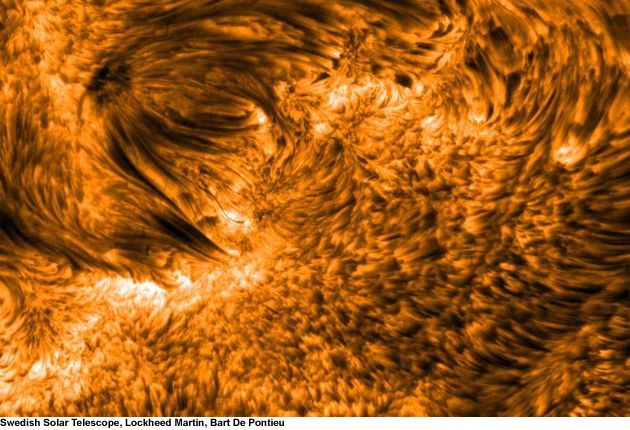Sun Spikes: Solar Quakes Fuel Hot Tendrils

Like hair energized by static electricity, thousands upon thousands of glowing tendrils reach out from the Sun. Since these "spicules" of hot gas were discovered in 1877, scientists have been scratching their heads over what causes them.
New observations by three observatories coupled with powerful computer modeling appear to have solved the mystery.
The spikes of superheated gas, called plasma, are small compared to many of the Sun's prominent features, such as giant loops of magnetic energy that are flung many thousands of miles into the solar atmosphere. The spicules are typically 300 miles (480 km) in diameter and shoot a relatively modest 3,000 miles (4,830 km) above the Sun's surface. They scream upward at 50,000 mph (22 kps) and then vanish within five minutes, making them hard to study.
More than 100,000 spicules tickle the solar atmosphere, called the corona, at any time.
Coincident cycles
The key to their origin is in the regular cycle with which spicules regenerate. Every five minutes or so, one leaps forth from the same spot, according to the new study. It so happens that the Sun has a well-known inner ring, much like that of a bell, that works on the same cycle.
"We developed a computer model of the Sun's atmosphere to show that the periodicity of the spicules is caused by sound waves at the solar surface that have the same five-minute period," said Robertus Erdelyi von F?y-Siebenb?rgen, a professor of applied mathematics at the University of Sheffield, UK.
Get the Space.com Newsletter
Breaking space news, the latest updates on rocket launches, skywatching events and more!
The ringing of the Sun involves seismic waves similar to those in an earthquake. They are usually damped down before they can leave the roiling surface and so continue bouncing around inside the Sun.
"They're basically sound waves that are trapped," said Bart De Pontieu, a solar physicist at the Lockheed Martin Solar and Astrophysics Lab. "For the most part they can't escape to the outside."
But the study found that some of the sound waves leak out, developing shock waves that propel matter upward to generate spicules and push them into the corona, De Pontieu explained in a telephone interview.
Feeding the solar wind?
The research team now wonders if spicules might contribute to the solar wind, a constant stream of charge particles emanating from the Sun and coursing through the solar system.
Scientists don't know exactly how the mass of the solar wind gets into the corona nor what accelerates the particles into space. The spicules are a good candidate, as they carry into the atmosphere more than 100 times the mass needed to feed the solar wind, the new study concludes.
"Most of the mass of the spicules comes back down," De Pontieu said. But only a fraction would have to remain high up to account for the solar wind. However, he said, it's not clear how much if any of the mass from the spicules remains in the corona, or if it is heated to the extent that appears to be required to create the super energetic particles of the solar wind.
Oddly, the corona is 1.8 million degrees Fahrenheit (1 million Celsius), while the Sun's surface is typically no more than 11,000 degrees Fahrenheit (6,000 Celsius). The reason remains one of the great mysteries of the Sun.
Group activity
Previous studies had found hints of the 5-minute cycle of spicules. But scientists had only studied them on the limb of the Sun, the periphery of the hot disk as seen from our vantagepoint. The new observations allowed the researchers to examine spicules across the face of the Sun.
The investigation showed that spicules occur in groups.
Spicules are usually associated with concentrated magnetic tubes called flux tubes, giant loops that link one region of magnetic polarity to another by arcing out from the surface and back to another spot thousands of miles away. The tubes are mostly vertical, but some are inclined away from the vertical, and that's where the sound waves tend to leak out, De Pontieu said.
The findings are detailed in the July 29 issue of the journal Nature. The work was based on observations by the Swedish Solar Telescope on the Spanish island of La Palma, as well as the orbiting SOHO and TRACE observatories.
- Sun Cams
- Anatomy of the Sun
- Quicktime Movie of Spicules Racing Outward (May Load Slowly)
Join our Space Forums to keep talking space on the latest missions, night sky and more! And if you have a news tip, correction or comment, let us know at: community@space.com.

Rob has been producing internet content since the mid-1990s. He was a writer, editor and Director of Site Operations at Space.com starting in 1999. He served as Managing Editor of LiveScience since its launch in 2004. He then oversaw news operations for the Space.com's then-parent company TechMediaNetwork's growing suite of technology, science and business news sites. Prior to joining the company, Rob was an editor at The Star-Ledger in New Jersey. He has a journalism degree from Humboldt State University in California, is an author and also writes for Medium.